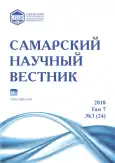Resource-saving methods of cultivation of grain crops and biological activity of ordinary black soil
- Authors: Zaushintsena A.V.1, Romanov V.N.2, Kozhevnikov N.V.1
-
Affiliations:
- Kemerovo State University
- Krasnoyarsk Research Institute of Agriculture, Federal Research Center «Krasnoyarsk Science Center SB RAS»
- Issue: Vol 7, No 3 (2018)
- Pages: 41-48
- Section: 03.02.00 – General Biology
- URL: https://journals.rcsi.science/2309-4370/article/view/21685
- DOI: https://doi.org/10.17816/snv201873108
- ID: 21685
Cite item
Full Text
Abstract
The article analyzes the role of resource-saving technologies to grain crop cultivation. Although there is a growing interest to the problem there is still a lack of theoretically analysis. Thus, the authors show the importance of resource-saving technologies in different soil and climate conditions. The article analyzes the influence of technological methods of soil cultivation on general biological activity of the chernozem of the Krasnoyarsk forest-steppe. The soil of the virgin variant is characterized by the greatest intensity of soil respiration and cellulolytic activity. Long-term processing of the chernozem of an ordinary experimental field led to a decrease of overall biological activity by an average of 30,5–33,5%. As a result, it has been established that methods of soil cultivation have a strong influence on biological activity and soil respiration during vegetation period. The greatest biological activity is observed at minimum soil cultivation. Hydrothermal conditions influence on the process of biological activity. High humidity caused a significant growth in cellulose-decomposing activity up to 27–38% and soil respiration by 17–24%. Humidity increasing caused the process of soil respiration. Cultivated crops didn’t influence on the process of biological activity. Zero cultivation caused the increasing spring wheat productivity on 0,93 c / ha and oat and barley productivity reducing. Minimum level of cultivation caused little barley and wheat productivity reducing on 0,25 c/ha. Reduced production costs and resource-saving technologies influence on both profit and the level of profitability increasing. Direct sowing to wheat (139,58%) and barley (142,24%) cultivation caused the highest level of profitability.
Full Text
##article.viewOnOriginalSite##About the authors
Alexandra Vasilyevna Zaushintsena
Kemerovo State University
Email: alexaz58@yandex.ru
doctor of biological sciences, professor of Botany Department
Russian Federation, KemerovoVasily Nikolaevich Romanov
Krasnoyarsk Research Institute of Agriculture, Federal Research Center «Krasnoyarsk Science Center SB RAS»
Email: romanov1948@yandex.ru
doctor of agricultural sciences, leading researcher of Agrotechnology Department
Russian Federation, KrasnoyarskNikolay Vladimirovich Kozhevnikov
Kemerovo State University
Author for correspondence.
Email: koghevnikov_nv@mail.ru
postgraduate student of Botany Department
Russian Federation, KemerovoReferences
- Дорожко Г.Р., Власова О.И., Тивиков А.И. Адаптивные энерго- и почвосберегающие технологии возделывания полевых культур // Экология и устойчивое развитие сельской местности. 2012. С. 91-95.
- Рябов Е.И. Ресурсосберегающие технологии возделывания сельскохозяйственных культур (Минимальная почвозащитная обработка, удобрения, пестициды, машины и орудия). Ставрополь: Изд-во СтГАУ «Агрус», 2003. 152 с.
- Пилецкая О.А. Биологическая активность черноземовидной почвы при использовании различных систем удобрения: дис. … канд. биол. наук. Благовещенск, 2015. 152 с.
- Казеев К.Ш., Колесников С.И. Биодиагностика почв: методология и методы исследований. Ростов-на-Дону: Издательство Южного федерального университета. 2012. 260 с.
- Даденко Е.В., Мясникова М.А., Казеев К.Ш., Колесников С.И., Вальков В.Ф. Биологическая активность чернозема обыкновенного при длительном использовании под пашню // Почвоведение. 2014. № 6. С. 724-733.
- Казеев К.Ш., Колесников С.И., Вальков В.Ф. Биологическая диагностика и индикация почв: методология и методы исследований. Ростов-на-Дону: Изд-во РГУ. 2003. 216 с.
- Щур А.В., Виноградов Д.В., Валько В.П. Целлюлозолитическая активность почв при различных уровнях агротехнического воздействия // Вестник КрасГАУ. 2015. № 7. С. 45-49.
- Курчевский С.М., Виноградов Д.В. Роль агромелиоративных приемов в улучшении основных агрофизических свойств супесчаной дерново-подзолистой почвы // Агропанорама. 2013. № 6. С. 10-12.
- Курганова И.Н. Эмиссия и баланс диоксида углерода в наземных экосистемах России: дис. … д-ра биол. наук: 03.00.27, 03.00.16. Пущино, 2010. 401 с.
- Звягинцев Д.Г. Методы почвенной микробиологии и биохимии. М.: Изд-во Моск. ун-та, 1991. 304 с.
- Федорец Н.Г., Медведева М.В. Методика исследования почв урбанизированных территорий. Петрозаводск: Карельский научный центр РАН, 2009. 84 с.
- Пряженникова О.Е. Целлюлозолитическая активность почв в условиях городской среды // Вестник Кемеровского государственного университета. 2015. № 3 (47). С. 10-13.
- Черкасов Г.Н., Масютенко Н.П., Масютенко М.Н. Влияние вида севооборота, системы обработки почвы и экспозиции склона на динамику эмиссии СО2 из чернозема типичного // Достижения науки и техники АПК, 2013. № 6. С. 34-37.
- Bekku Y.S., Nakatsubo T., Kume A. et. al. Effect of warming on the temperature dependence of soil respiration rate in arctic, temperate and tropical soils // Applied Soil Ecology. 2003. Vol. 22. P. 205-210.
- Chen H., Tian H.-Q. Does a general temperature-dependent Q10 model of soil respiration exist at biome and global scale? // Journal of Integrative Plant Biology. 2005. Vol. 47, № 11. P. 1288-1302.
- Шарков И.Н., Шепелев А.Г., Мишина Г.В. Продуцирование СО2 пашней на черноземе выщелоченном в условиях центральной лесостепи Западной Сибири // Агрохимия. 2013. № 5. С. 51-57.
- Thierfelder C., Chisui J.L., Gama M., Cheeseman S., Jere Z.D., Bunderson W.T., Eash N.S., Rusinamhodzi L. Mai-based Conservation Agriculture systems in Malawi: Long-term trends in productivity. Field Crops Research, 142. 2013. P. 47-57.
- Романов В.Н., Петровский Н.В., Колесников А.С. Продуктивность культур в зависимости от основной обработки почвы в условиях Красноярской лесостепи // Вестник Красноярского государственного аграрного университета. 2014. № 3. С. 63-66.
- Кузнецова Т.Г. Влияние приемов биологизации обработки почвы на засоренность посевов и урожайность культур: дис. … канд. с/х. наук. Воронеж, 2014. 142 с.
- Романов В.Н., Колесников А.С., Заушинцена А.В., Кожевников Н.В. Энергетическая оценка ресурсосберегающих технологий возделывания зерновых культур в условиях лесостепи Красноярского края // Вестник КрасГАУ. 2018. № 2. С. 9-16.
Supplementary files










